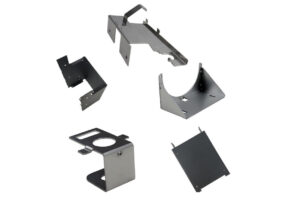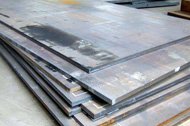Steel Sheet Metal Fabrication: Choosing the Right Alloy and Technique

To ensure a successful steel sheet metal fabrication process, it is crucial to select the appropriate alloy and technique. This comprehensive guide aims to assist you in choosing the right steel alloys and provides recommendations for various fabrication techniques. Additionally, valuable resources will be included for your reference.
Understanding Different Steel Types in Sheet Metal Fabrication
Before proceeding with sheet metal fabrication, it is essential to familiarize yourself with the properties of various steel alloys. Each alloy possesses unique characteristics that make them suitable for specific fabrication techniques such as
- laser cutting,
- plasma cutting,
- bending, drilling, or milling.
Common Alloy Steels
Alloy Steel: Formed by combining carbon steel with additional components, typically metals and non-metals, alloy steel exhibits altered chemical and physical properties. The alloying elements impact mechanical attributes like high strength for forging and weldability during fabrication.
Types of Alloy Steel

There are two categories of alloy steel based on the weight of the alloying elements:
- High-Alloy Steel: Contains alloying elements exceeding 8%, resulting in higher costs compared to low-alloy steel. Typically used in vehicles and industrial machinery.
- Low-Alloy Steel: With alloying elements below 8%, offering a range of strengths and applications dictated by the specific alloying components.
Influence of Alloying Elements
By blending carbon steel with various alloying elements, distinct properties can be achieved. Some commonly used elements and their effects include:
- Aluminium: Enhances surface hardness by eliminating oxygen, phosphorus, and sulfur, making it ideal for forging processes.
- Tungsten: Improves grain structure, strength, hardness, and heat resistance for fabrication involving force and heat.
- Chromium: Enhances toughness, hardness, and wear resistance, crucial for forming techniques like cold forging.
- Cobalt: Boosts hot hardness, toughness, and wear resistance, facilitating hot working operations.
- Vanadium: Enhances toughness, strength, shock and corrosion resistance, beneficial for operations such as blanking and bending.
- Copper: Increases hardness and corrosion resistance, enhancing machinability.
- Manganese: Improves surface hardness, ductility, wear resistance, strength at high temperatures, and strain resistance for hot working and weldability.
- Molybdenum: Strengthens alloy steel and improves heat and stress resilience, vital for processes requiring heat treatment.
- Nickel: Enhances corrosion resistance, hardness, and strength, ideal for cold forging applications.
- Silicon: Improves magnetic properties and strength, essential for fabrication techniques involving force application.
Applications of Alloy Steel
Alloy steel sheets are commonly used in various applications, including:
- Corrosion-resistant containers, silverware, heating elements, and pots and pans.
- Aviation parts, structural sections, girders, and ship propellers.
- Structural parts, mining equipment, automobile manufacturing, and railroad cars.
By understanding the properties of different steel alloys and selecting the appropriate alloy for your fabrication needs, you can ensure a successful steel sheet metal fabrication process.
Certainly! Here is a rewritten version of the provided text:
Carbon Steel

Carbon steel contains a higher carbon content compared to stainless steel, providing increased durability and lowering the melting point. It is the primary material used in most steel sheet metal fabrication processes.
Types of Carbon Steel
- 1. Low-Carbon Steel: Contains less than 0.25% carbon, making it the most commonly used type. However, its brittleness and susceptibility to deformation under tension make it unsuitable for harsh fabrication techniques like punching.
– Properties: More brittle and ductile, easier to weld, less expensive to machine, deforms under tension.
– Applications: Making steel plates, fabricating vehicle body panels, manufacturing food cans. - 2. Medium-Carbon Steel: Contains manganese ranging from 0.6% to 1.65% and carbon between 0.25% and 0.6%. It offers improved mechanical qualities suitable for cold working techniques like bending and shearing during fabrication.
– Properties: Heat treatment enhances mechanical qualities, stronger than low-carbon steel, less ductile but more robust, high wear resistance and enhanced toughness.
– Applications: Making railway tracks and wheels, producing machinery parts such as gears. - 3. High Carbon Steel: Contains 0.3-0.9% manganese and 0.6-1.25% carbon, making it the strongest and most durable type. Highly machinable, it can be manipulated using methods like shearing, bending, and rolling.
– Properties: High wear resistance, low ductility, requires constant hardening and tempering, breaks easily under tension.
– Applications: Fabrication of bridge components, structures in oil and gas industries, shipbuilding.
Applications of Steel Sheet Metal Fabricated Parts
Steel sheet metal fabricated parts are utilized in various sectors such as construction, mining, and the energy industry. These parts offer durability, strength, and affordability relative to other materials.
Drawbacks of Steel Sheet Metal Fabrication
– Long lifespan but susceptible to oxidation-induced corrosion over time.
– Extended exposure to elements can lead to buckling and collapsing.
Steel Sheet Metal Fabrication Services
At MetalfabricationChina, we specialize in designing and fabricating steel sheet material parts tailored to your specific requirements. Our team of engineers and technicians provides services including steel part design, laser cutting, stamping, welding, bending, and surface finishing for steel sheet parts. We ensure precise and quality parts at competitive prices.
Conclusion
Understanding the properties of steel enables you to select the appropriate sheet metal fabrication method for your needs, ensuring that the fabricated parts meet specific application requirements.
For all your steel sheet metal fabrication needs, feel free to contact us.
If you need further assistance or information, please do not hesitate to reach out to us.
More Resources:
Sheet Metal Fabrication – Source from ThomasNet
